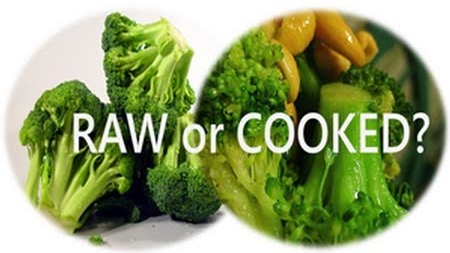Vegetables should carefully be cleaned (brushing, peeling, remove unsavory leaves and affected parts) and then washed in not more water than necessary, before cutting them. Otherwise you will lose a lot of the juices from the cuts.
‘Raw food’ as a trendy and hot fashion, would contain more nutrients.
Raw-food-ism or crudivorisme – eating only raw foods - has lately become popular again.
 Benefits of raw food
Benefits of raw food
Raw legumes contain lectins that affect various metabolic processes.
Fruits and vegetables are spicier, crispier, more powerful, pure, tasty.
Disadvantages of cooking
The longer it takes to cook, the more the content oxidizes of air (oxygen) and may cause damage. By cooking vegetables, soluble minerals and vitamins and enzymes escape into the cooking liquid. This is the case with the most vulnerable vitamin C, but also with vitamins B1 and B9.
Lectins in raw legumes degrade when cooked.
Too long cooking cabbage crops destroy all antioxidants herein completely.
Cooked food has a negative effect on the functioning of the immune system. It should be less active allowing the resistivity deteriorate significantly.
Advantage of cooking
Heat kills bacteria.
Because cooking breaks open the cell wall structure, the body can better digest lots of vegetables and take up easier the nutrients. For example lycopenes are better absorbed from canned tomatoes and tomato ketchup than from raw tomatoes. This is also true for vitamins, carotenoids and other nutrients from manufactured products.
By heating, certain vitamins and minerals are set free; bioavailability of these substances is increased and they are better absorbed by the body, such as provitamin A. It is also good to add a little oil, it solves provitamin A better and is better absorbed in the body.
Carrots, broccoli and zucchini that were cooked - and certainly steamed - just contain more antioxidants such as vitamin C and carotenes than raw.
After cooking fibers are better tolerated and irritate less.
Cooked food tastes and smells better, is softer, more tender, digest better, is safer.
Disadvantages of raw food
Foods that’s produced quickly and massively is vulnerable to bacteria that can multiply quickly. Raw vegetables can contain dangerous bacteria (EHEC,...)
There is almost no clean (uncontaminated, unpolluted) ditch- or groundwater available for fields.
Also manure from intensive farming can bring resistant bacteria in the fields.
Potatoes are poisonous, but that ‘s greatly reduced by boiling them.
Vitamin B12 is only produced by microorganisms (bacteria and archaea). For man active forms of this are found only in animal foods. By eating only raw vegetables vitamin B12 deficiency arises. Would be remedied by occasionally eating ants.
A healthy variation is certainly both raw and cooked vegetables.
Boiling or steaming is better kept as short as possible, with as little water as possible.
And you can often recycle the liquid for soup or sauce. (see <Cooking liquid>)
When cooking some types of vegetables, extra nutrients are released. Cooking breaks open the cell wall structure, making digestiation easier.
Asparagus is hard. This makes it difficult for our bodies to take in. Boiled, antioxidants are released, and you can absorb vitamins A, C and E more easily.
Same story for pumpkin and carrots (with beta-carotene, which you convert into vitamin A).
When you heat mushrooms, protein, vitamin B and minerals are released.
With spinach, cooking concentrates calcium, iron and magnesium.
Rhubarb (oxalic acid), or red kidney beans (lectin, a natural poison) should not be eaten raw.
A cooked potato is 20 times more digestible than a raw one. As a result, you need less food and less time to process (chew).
Peppers, beets and onion are best eaten raw.
